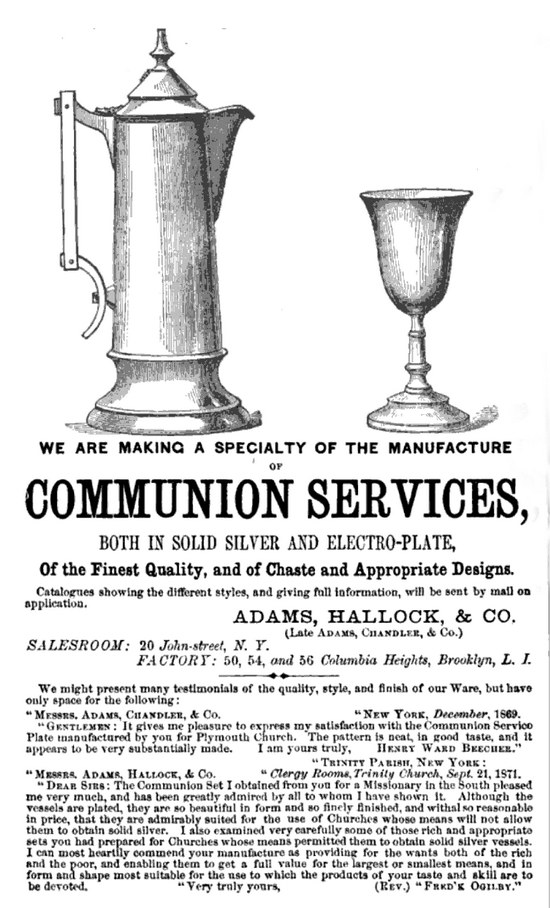John Popkin Adams
- Born: 21 Apr 1837, Newbury MA
- Died: 2 Jul 1895, New York City NY
General notes:
Silverplater
Events in his life were:
- Partnership: Benjamin Price, in 1867-1868, in New York City NY. As ADAMS, PRICE & Co, with a sales room at 20 John Street and a manufacturing factory in Brooklyn. 12
- Partnership: Henry Sweeting Chandler, in 1869-1870, in New York City NY. As ADAMS, CHANDLER & Co. 12

- He was issued patent number 93,575 on 10 Aug 1869
JOHN P. ADAMS, OF NEW YORK, ASSIGNOR TO HIMSELF, HENRY S. CHANDLER, AND MARCUS ORMSBEE, OF BROOKLYN, NEW YORK.
Letters Patent No. 93,575, dated August 10, 1869.
IMPROVED REVOLVING ICE-PITCHER AND COFFEE-POT.
To all whom it may concern:
Be it known that I, John P. Adams, of the city, county, and State of New York, have invented certain Improvements in Tilting and Revolving Ice-Pitchers and Coffee-Pots.
My invention relates to the novel combination of a slop-bowl with a tilting and revolving ice-pitcher or similar vessel adapted to table-use, and also to the novel arrangement of operative parts, by means of which the revolving movement is effected with, as it is believed, the least practicable degree of friction; and I do hereby declare that the following specification, taken in connection with the drawings furnished, and forming a part of the same, is a true, clear, and exact description thereof-Having reference to the drawings—
Figure 1 represents, in elevation view, one of my improved vessels.
Figure 2 represents, in vertical section, that portion of the same which contains my improvements.
In each figure the corresponding parts are lettered alike.
A represents the base.
B represents the slop-bowl, resting upon the base, and connected therewith by means of a spindle, attached to the under side of the bowl.
This spindle is nicely adjusted to a barrel-socket in the centre of the base, and so arranged that friction results only from the bearing between the top of the barrel-socket and the under side of the bowl, and the outer surface of the spindle and the inner surface of the socket.
This bowl is provided with a concave top, suitably provided with perforations for the passage of fluids to its interior; also with apertures for the discharge of the same, so placed, beneath the standards 0, as to be entirely hidden from view.
The perforated top may not be desired, in which case the interior would be entirely exposed.
To more fully facilitate the pouring of slops into the bowl, it could be provided with a projecting lip.in an obvious manner.
E represents the spindle, which may be made of hollow metal, or solid, as desired.
C and C represent standards, upon the tops of which the vessel or pitcher is placed, and balanced by means of trunnions attached to the sides of the pitcher.
D is the pitcher, so balanced that of its own weight
a perpendicular position is of itself maintained. It is provided with a stop to prevent its tilting backward.
The mode of operation of the several parts is clearly obvious.
I am aware that a tilting and revolving vessel, substantially as described, is not new; but I am not aware that the useful and desirable combination of a slop-bowl therewith has ever before been effected.
I am also aware of the fact that the revolving movement heretofore effected was by means of a horizontal circular table, mounted upon a spindle, which, in turn, was mounted upon a step, and depending for its vertical position upon the bearings of the periphery of the table upon a socket or rim, formed in the inside of the top of the base.
When thus constructed, the friction of the parts is at a distance from the axis.
To obviate this friction and reduce it as much as possible, is one of the objects of my present invention.
This is accomplished by having the bearing or weight of the bowl, standards, and pitcher concentrated at a point between the under side of the bowl and the base, at or near the top of the socket, which receives the spindle E.
All friction resulting from the revolving movement is therefore confined to the surfaces described, adjacent to the centre of motion, and to the vertical surfaces between the spindle and its socket, securing at all times a free rotary movement.
Having thus described my invention, I claim as new, and desire to secure by Letters Patent of the United States—
1. The combination of a slop-bowl with a vessel arranged to tilt, revolve, or both, adapted to table-use, and arranged to operate substantially as herein shown and described.
2. The improvement in revolving vessels of the character herein described, which consists in mounting the revolving member upon a spindle, so arranged, relatively to its socket, that friction only results from the contact of the surfaces between the under side of such member and the upper side of the base, adjacent to the centre, and between the vertical sides of the spindle and the inner side of the socket, substantially as shown and described.
John P. Adams
Witnesses:
Simon H. Stern
Henry H. Root
- Partnership: Lucius Edgar Hallock, in 1871-1876, in New York City NY. As ADAMS, HALLOCK & Co., with a shop at 20 John Street.

- Advertised: The Methodist Almanac, in 1872.
|



